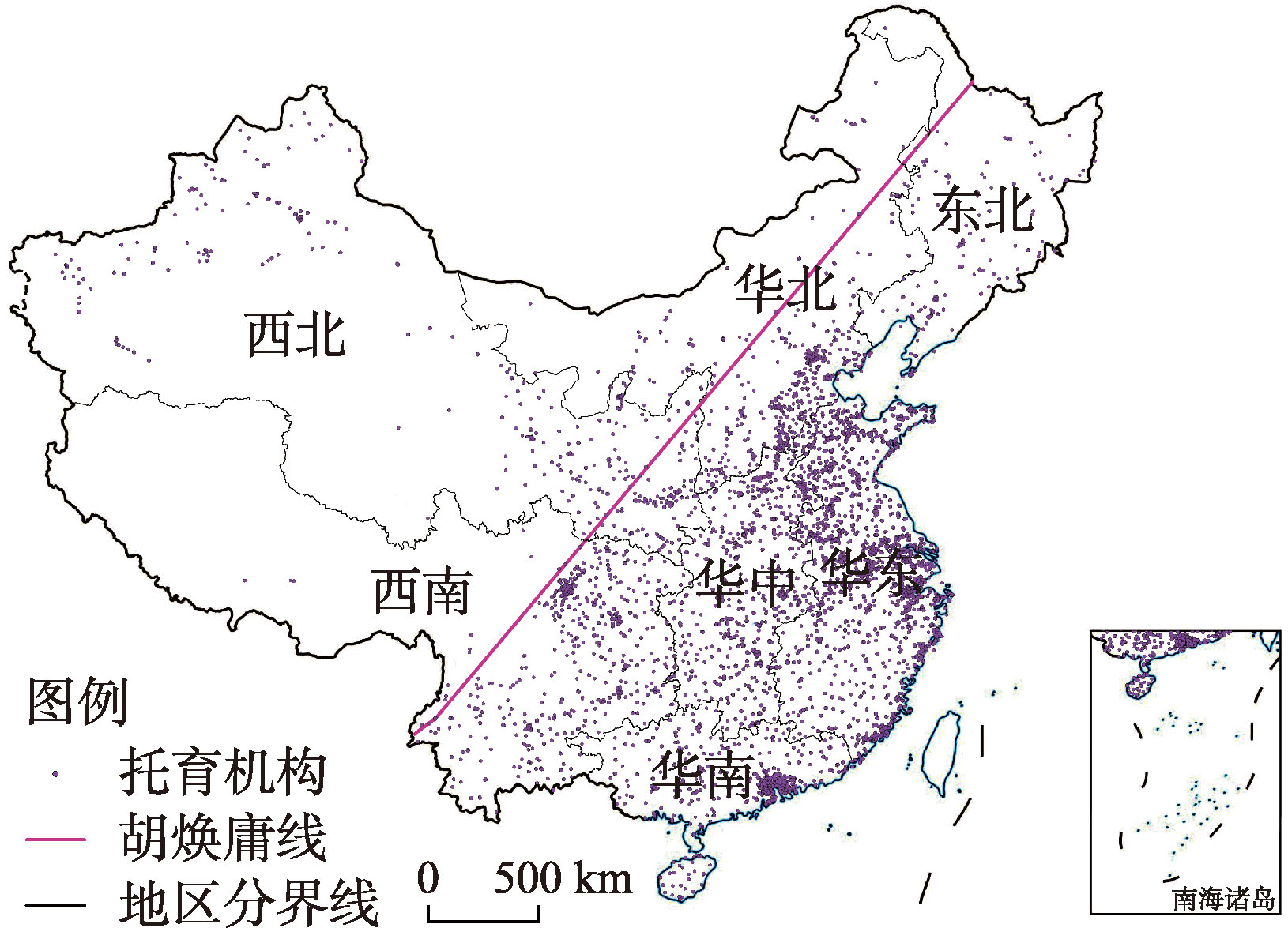

中国托育机构空间分异特征与影响因素
|
鄢继尧(1997-), 男, 四川成都人, 博士, 研究方向为经济地理与区域规划。E-mail: njnuyanjiyao@qq.com |
收稿日期: 2023-03-24
修回日期: 2024-06-18
网络出版日期: 2024-12-27
基金资助
国家社会科学基金项目(20BSH116)
Spatial differentiation characteristics and influencing factors of childcare institutions in China
Received date: 2023-03-24
Revised date: 2024-06-18
Online published: 2024-12-27
Supported by
National Social Science Foundation of China(20BSH116)
基于国家卫生健康委员会2024年6月公布的托育机构数据,以中国336个地级行政区为研究单元,运用ArcGIS空间分析方法探究中国托育机构的空间分异特征,采用地理加权回归揭示空间分异的影响因素。研究发现:① 中国托育机构总体呈现东多西少的集聚型分布格局,“大集聚、小分散”的空间分布特征显著,形成长三角、珠三角、环渤海三大高密度区和多个以省会、首府为核心的单核集聚点;② 中国托育机构数量与城市等级呈明显正相关,托育机构数量少、较少的城市数量多、范围广。数量多的城市基本位于东部沿海地区,在成都、重庆、合肥、郑州等中西部直辖市或省会城市也有分布,数量少的城市广泛分布在西部和东北地区。③ 0~4岁人口数量对托育机构空间分异具有决定性作用,城镇居民人均可支配收入、劳动参与率、平均家庭户规模是影响托育机构空间分异的辅助因素。除平均家庭户规模总体上呈负向影响外,其他因子总体上呈正向影响。伴随城市等级的下降,各辅助因素的影响力呈逐级递减趋势,对五线城市的影响力极其有限。最后为中国托育服务业发展提出了针对性的对策建议。

鄢继尧 , 赵媛 , 谭万丽 , 熊筱燕 , 赵丽芬 . 中国托育机构空间分异特征与影响因素[J]. 地理学报, 2024 , 79(12) : 3197 -3209 . DOI: 10.11821/dlxb202412017
Based on the data from childcare institutions released by the National Health Commission in June 2024, this study examines the spatial differentiation of childcare institutions across China using four provincial-level cities and 332 prefecture-level regions. The research employs ArcGIS spatial analysis methods and Geographically Weighted Regression (GWR) to uncover the influencing factors behind this spatial variation. Key findings include: (1) Childcare institutions in China predominantly exhibit a clustered distribution, characterized by a greater concentration in the east and sparser distribution in the west. This pattern manifests as "large clusters and small dispersions," with significant clusters forming in the Yangtze River Delta, Pearl River Delta, and Bohai Rim, and numerous monocentric clusters centered around provincial capitals and major cities. (2) The number of childcare institutions is positively correlated with the tier of the city. Cities with fewer childcare facilities are numerous and spread out, primarily located in the western and northeastern regions. In contrast, cities with a larger number of institutions are mainly situated in the eastern coastal areas and major central-western cities such as Chengdu, Chongqing, Hefei, and Zhengzhou. (3) The population of children aged 0-4 years plays a decisive role in the spatial distribution of childcare institutions. Per capita disposable income of urban residents, the labor participation rate, and average household size serve as auxiliary factors influencing this spatial variation. While the average household size generally has a negative influence, other factors positively affect the distribution. As city tiers decrease, the impact of these auxiliary factors lessens, with minimal influence on fifth-tier cities. In conclusion, the study offers targeted recommendations for the development of China's childcare services industry.

表1 最小二乘法(OLS)和地理加权回归(GWR)结果对比Tab. 1 Comparison of Ordinary Least Squares (OLS) and Geographically Weighted Regression (GWR) results |
| 指标 | AICc | R2 | 校正R² |
|---|---|---|---|
| OLS | -688.43 | 0.6282 | 0.6226 |
| GWR | -702.53 | 0.6793 | 0.6491 |
表2 GWR模型回归系数描述性统计与方差膨胀因子(VIF)Tab. 2 Descriptive statistics and Variance Inflation Factor (VIF) for GWR model regression coefficients |
| 指标 | 平均值 | 标准差 | 变异系数 | 正值占比(%) | 负值占比(%) | VIF |
|---|---|---|---|---|---|---|
| 0~4岁人口数量 | 0.6471 | 0.0730 | 0.1129 | 100 | 0 | 1.6930 |
| 城镇居民人均可支配收入 | 0.1872 | 0.0558 | 0.2978 | 100 | 0 | 1.4225 |
| 劳动参与率 | 0.1563 | 0.1586 | 1.0151 | 86.90 | 13.10 | 1.3934 |
| 平均家庭户规模 | -0.1359 | 0.3331 | -2.4507 | 30.06 | 69.94 | 1.4935 |
| [1] |
[杨菊华. 理论基础、现实依据与改革思路: 中国3岁以下婴幼儿托育服务发展研究. 社会科学, 2018(9): 89-100.]
|
| [2] |
|
| [3] |
[范昕, 李敏谊, 叶品. 托幼服务治理模式国际比较及中国路径选择. 比较教育研究, 2021, 43(1): 104-112.]
|
| [4] |
[赵媛, 鄢继尧. 从生育、养育、教育全视角促进三孩生育政策落实落细. 中国妇女报, 2022-03-22(5).]
|
| [5] |
|
| [6] |
[洪秀敏, 王靖渊, 朱文婷. 第四代评价理论视域下国际托育机构质量评价的价值意蕴、路径选择及启示. 教育发展研究, 2022, 42(2): 28-35, 46.]
|
| [7] |
[海颖, 高金岭. 低生育率下我国学前教育托幼一体化供给潜力预测: 基于2023—2035年人口趋势的研究. 教育与经济, 2023, 39(3): 86-94, 96.]
|
| [8] |
[王雅楠, 高传胜, 刘竞龙. 托育服务发展中的社会力量与政府作用: 基于上海市民办托育机构空间分布的公平与效率分析. 当代经济管理, 2022, 44(12): 39-49.]
|
| [9] |
|
| [10] |
|
| [11] |
|
| [12] |
|
| [13] |
|
| [14] |
|
| [15] |
[洪秀敏, 陶鑫萌, 李汉东. “全面二孩”政策下托育服务资源需求规模预测: 基于对2020—2035年城乡0-3岁婴幼儿人口的估算. 学前教育研究, 2021(2): 16-29.]
|
| [16] |
[黄宸, 李玲. “三孩”政策下2022—2050年城乡托育服务适龄人口与资源供给. 教育研究, 2022, 43(9): 107-117.]
|
| [17] |
[高琛卓, 杨雪燕, 井文. 城市父母对0-3 岁婴幼儿托育服务的需求偏好: 基于选择实验法的实证分析. 人口研究, 2020, 44(1): 85-98.]
|
| [18] |
[史瑾, 张静. 父母对0-3 岁托育机构的需求偏好及支付意愿的回溯研究. 基础教育, 2021, 18(5): 82-91.]
|
| [19] |
[史薇. 隔代照料对城市双职家庭婴幼儿照护服务需求的影响: 兼论家庭经济收入的调节效应. 消费经济, 2019, 35(6): 3-12.]
|
| [20] |
[石智雷, 刘思辰. 大城市3岁以下婴幼儿照护方式及机构照护需求研究. 人口学刊, 2020, 42(5): 17-30.]
|
| [21] |
[杨雪燕, 井文, 王洒洒, 等. 中国0-3岁婴幼儿托育服务实践模式评估. 人口学刊, 2019, 41(1): 5-19.]
|
| [22] |
[洪秀敏, 赵思婕, 朱文婷. 托育服务供给模式及其普惠成效的国际比较与启示. 教育与经济, 2021, 37(4): 81-88, 96.]
|
| [23] |
[刘天子, 杨立华, 曾晓东. 不同国家托育服务治理模式的效果评价: 基于OECD家庭数据库的比较分析. 人口学刊, 2022, 44(4): 70-79.]
|
| [24] |
[陈宁, 高卫星, 陆薇, 等. 婴幼儿托育机构发展瓶颈、政策需求与治理取向: 基于河南省2679个托育机构的调查. 人口研究, 2022, 46(2): 117-128.]
|
| [25] |
[刘敏, 沈紫琼, 洪彬雪, 等. 基于供需适配性理论的四川省3岁以下婴幼儿照护服务分析. 四川大学学报(医学版), 2022, 53(4): 663-669.]
|
| [26] |
[石智雷, 滕聪波. 三孩政策下托育服务可及性与生育释放效应. 人口学刊, 2023, 45 (2): 28-43.]
|
| [27] |
[王金伟, 郭嘉欣, 刘乙, 等. 中国滑雪场空间分布特征及其影响因素. 地理研究, 2022, 41(2): 390-405.]
|
| [28] |
[王秀伟, 李晓军. 中国乡村旅游重点村的空间特征与影响因素. 地理学报, 2022, 77(4): 900-917.]
|
| [29] |
[汪凡, 白永平, 周亮, 等. 中国基础教育公共服务均等化空间格局及其影响因素. 地理研究, 2019, 38(2): 285-296.]
|
| [30] |
[刘涛, 彭荣熙, 卓云霞, 等. 2000—2020年中国人口分布格局演变及影响因素. 地理学报, 2022, 77(2): 381-394.]
|
| [31] |
[穆学英, 崔璨, 崔军茹, 等. 中国流动人口的跨等级流动及其对流入城市住房选择的影响. 地理学报, 2022, 77(2): 395-410.]
|
| [32] |
[姜磊, 陈星宇, 朱竑. 中国城市养老院的空间分布特征及其分异成因. 地理学报, 2021, 76(8): 1951-1964.]
|
| [33] |
[曾浩淼, 张学敏, 任启琳, 等. 职业教育资源分布影响因素及空间均衡性研究. 地理学报, 2022, 77(12): 3180-3193.]
|
| [34] |
[冉钊, 高建华, 杨捷, 等. 中国商业健身资源集聚的格局演化及其形成机理. 地理学报, 2023, 78(6): 1573-1590.]
|
| [35] |
[赵媛, 鄢继尧, 熊筱燕. 中国家政服务业发展报告(2023). 北京: 中国劳动社会保障出版社, 2023.]
|
| [36] |
[鄢继尧, 赵媛, 许昕, 等. 基于网络关注度的中国城市家政服务需求时空演变及影响因素. 经济地理, 2021, 41(11): 56-64.]
|
| [37] |
[吴燕. 婴幼儿照护个人所得税专项附加扣除效应研究. 税收经济研究, 2022, 27(5): 29-38.]
|
| [38] |
[高传胜. 幼有所育, 当问谁?少子老龄化形势下托育服务的高质量发展. 贵州社会科学, 2023(5): 97-105.]
|
/
| 〈 |
|
〉 |